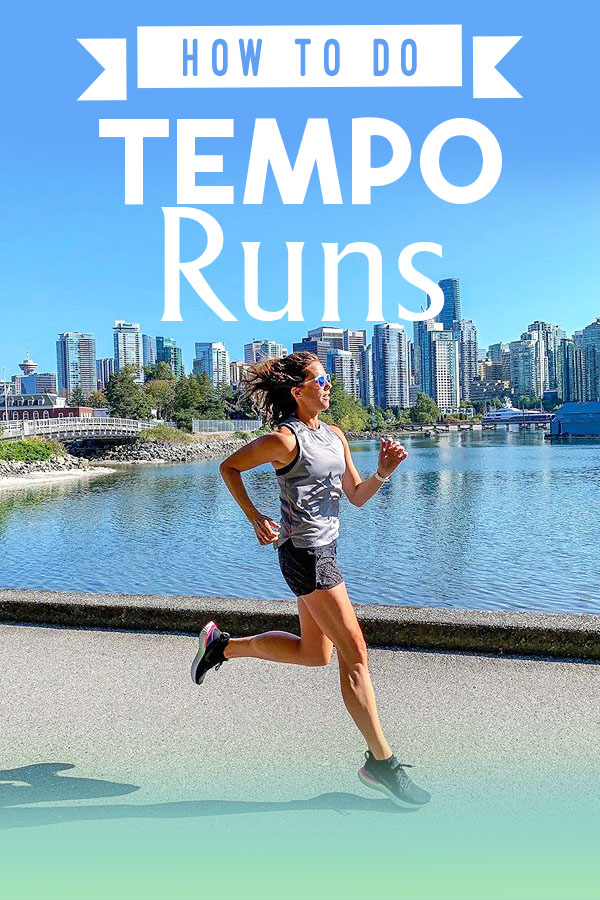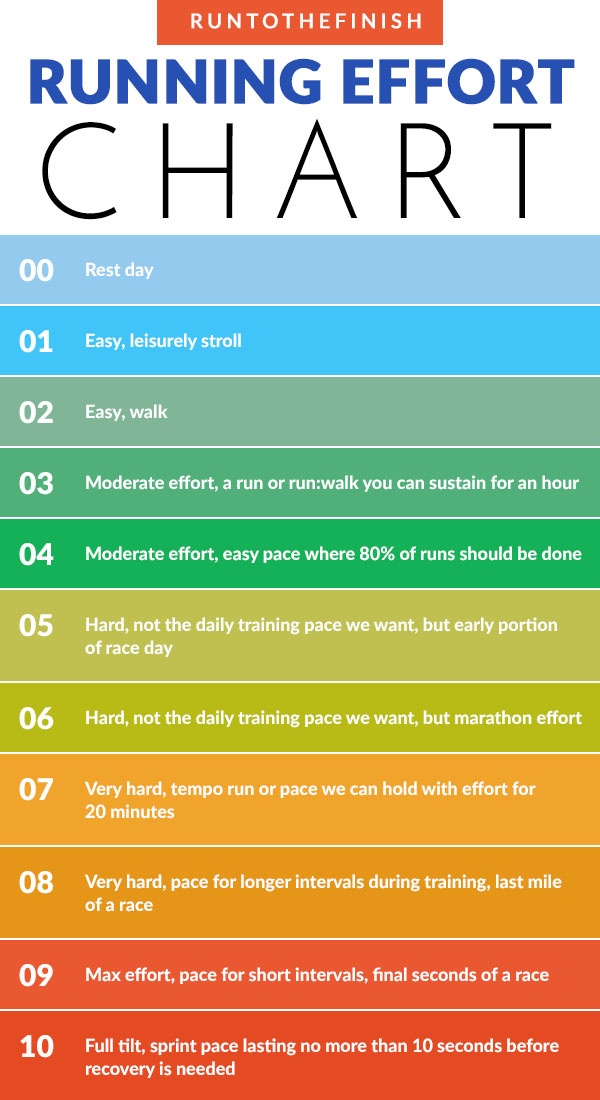What is a tempo run? Well, if you’re looking to increase speed and endurance, tempo runs are what you’ve been looking for. These workouts help teach your body how to hold a faster pace and don’t require as much recovery as harder intervals when done correctly. A useful part of an intermediate or advanced half or full marathon training plan, the execution for this workout is widely misunderstood and often done incorrectly.
A useful part of an intermediate or advanced half or full marathon training plan, the execution for this workout is widely misunderstood and often done incorrectly.
As a member of the speed training family, tempo runs, when performed properly, increase both endurance and speed.
Read along to find out everything you need to know about tempo runs!
What Are Tempo Runs?
Generally speaking, a tempo run is exactly what it sounds like: a sustained running pace faster than an easy pace, but slower than a sprint. Its purpose is to build up your body’s ability to run faster for longer periods of time.
It was first introduced by the famous running coach Jack Daniels in his 1998 book, Daniels’ Running Formula. His methods were always focused on the faster and elite runners, but they can be adapted to work well for many of us in the middle of the pack too.
Unfortunately, it’s very easy to do tempo runs too hard or too long, which then actually negates the goal of the workout!
By understanding how it affects your body, not only will you know exactly how to do a tempo run, but also learn if it’s a right fit for your training plan.
For this, we need to look at a more technical definition of tempo runs:
Tempo run is a short, sustained effort just above our anaerobic threshold when our body goes from having sufficient oxygen during the run to no longer having it to power our muscles. And that sweet spot, right in the middle, is where all the magic happens.
How to Calculate Your Tempo Pace?
While you certainly can use a calculator to determine an estimated tempo effort, it’s hugely valuable to learn to run by feel.
This is going to serve you well when trying to pace yourself on race day.
So how fast is a tempo? It depends on where you are in training and your current speed, and so there are four ways to calculate your personal tempo pace:
1. At 80-90% max heart rate:
It is an 80 to 90% maximum heart rate effort, for those who use heart rate training.
Remember that the longer you run at a harder effort your HR will increase, so it may not be at 80 % right away and that doesn’t mean you need to speed up. Instead, we need to find a pace you can sustain for the duration of the effort.
Remember these are not sprints or short fast intervals.
2. A ‘comfortably hard’ pace:
Aim for a pace that falls within an effort level between 6-8 on a scale of 10. Checkout the RPE chart below to help gauge your effort levels if you haven’t been doing this previously.
3. A pace between your 10K and half marathon pace:
A tempo run pace that can be compared to 30-45 seconds slower than 5K, which should roughly translate to your 10K pace or just a bit slower, but faster than your half marathon pace.
4. A pace where it’s harder to hold a conversation:
It is a pace you can run where you can’t easily talk yet aren’t gasping for air.
These runs should feel hard, but not I’ve sprinted around the track and need to puke in a trashcan kind of hard. More the I need to mentally tell myself I can do this hard.
Remember, you’re running at your body’s lactate threshold pace, which means you are going to feel that pain in your legs of fatigue. Focus on the effort level to determine if you should keep pushing or pull back.
Checkout our training paces calculator to help you even better define it >>
How to Do Tempo Runs?
As explained above, a tempo run is a sustained effort run at a race just above your anaerobic threshold.
This would be a run we could consider ‘comfortably hard’. Here’s how to do them:
- Ideally, you’ll start with just 5 minutes, working up to 20-minute segments.
- Most runners would max out at 2 or 3 tempo segments during a long run.
- Over time you want to see that your effort level remains the same, but your pace improves.
Example tempo run workouts:
- Easy warm-up miles, 5 minutes tempo, 10 minutes easy, 5 minutes tempo, easy cooldown miles
- Easy warm-up miles, 20 minutes tempo, easy cooldown miles
- Easy warm-up miles, 20 minutes tempo, 10 minutes easy, 20 minutes tempo, easy cooldown miles
Doing 20 minutes at tempo is an advanced workout. It’s not something that you need to do weekly, but rather a workout to incorporate in to the mix.
Remember if you are running these too hard then you are increasing the time needed for your body to recover. That is not the goal of these days, so really work on holding yourself to the goal pace.

Types of Tempo (Threshold) Runs
To fully understand what this means for us, let’s look at the three different types of tempo runs and then start putting paces to those.
1. Aerobic running
Aerobic literally means ‘with or involving energy’.
This is the zone we’re running in 80% of the time (assuming you’re correctly doing easy runs!).
This means your muscles have sufficient oxygen during physical effort to produce the energy it needs.
Being in this zone while running allows us to run greater distances and for longer periods of time. This means, that the higher your aerobic threshold is the faster and longer you can run before your body goes into the zone where it doesn’t have sufficient oxygen to power your muscles.
This is the backbone of marathon training and the Low Heart Rate Method I love so much. For most runners, this is going to be near your current marathon race pace.
So, it would make sense for our goal to be to prolong the time we can run in this threshold while training.
Now let’s look at the next zone our body can be in…
2. Anaerobic running
Anaerobic literally means ‘without oxygen’.
This is the other term you’ve likely heard over the years to refer to HARD efforts. At this point, the body no longer has enough oxygen to power the muscles.
Now, the body must break down sugar for fuel, which also means they’re producing excess lactate.
This excess contributes to that burning sensation in your legs since it accumulates in the blood stream faster than it can be cleared away.
3. Lactate threshold running
Lactate threshold is a point at which lactic acid is just starting to accumulate in our bodies. It’s different from the anaerobic threshold because that is when lactic acid builds faster than our bodies can clear it out.
This means that our lactate threshold pace is the maximum speed at which we can run while still allowing our body to promote lactate clearance.
Confused yet?
It refers to that sweet spot we want to aim for during a tempo run, not because this is a pace we want to hold for race day or to burn more fat, but because it’s the pace that’s defining our limits.
It teaches our bodies to maintain a pace for longer periods of time.
For this reason, these workouts are taxing on the body and need to be spaced out from other intense efforts or long runs.
But it’s also the reason why they come with a bunch of benefits.
4 Benefits of Tempo Runs
There are a few specific reasons why we include tempo runs in our marathon training plans.
1. Improving speed and distance
By doing tempo runs, we push our bodies to run faster for longer periods of time thus building our stamina. It increases our aerobic capacity and delays the onset of lactic acid building up in our bodies.
Aerobic capacity is when our bodies are able to supply muscles continuously with sufficient levels of oxygen.
And this is exactly what we need while training for a marathon!
2. Training body’s ability to handle lactic acid
By pushing our limits and being in a state where our body is just starting to accumulate lactic acid, but still clearing it out simultaneously we are training ourselves to handle lactic acid better.
This enables us to build endurance, something every runner needs to become better.
3. Practicing mental toughness
By training at a pace just outside our comfort zone, we tap into our inner selves and concentrate more than we normally would during a regular training session.
Doing so helps practice mental toughness which is exactly what we need while training for a competitive race or marathon.
4, Improving confidence
By regularly testing our limits, finishing a race starts feeling like it’s more achievable.
Feeling this consistently is what builds and improves our confidence. And tempo runs are exactly what you need to feel this way regularly.

What is the difference between tempo runs, fartleks, and intervals?
Tempo running is a type of speed workout that falls in the same category as fartlek and interval workouts, though those two serve different purposes.
The many types of speed workouts tend to get muddled together, however, they all serve a different purpose, while also contributing toward faster performance, better running economy, and longer endurance efforts.
The three most common methods are tempo runs, fartleks, and intervals.
Each workout requires a 10-15 min jogging warm-up and cool down, and don’t you forget to include that dynamic warm-up to stay injury-free!!
- Tempo runs: Sustained effort to build endurance and speed.
- Fartlek Runs: Playful short bursts with plenty of recovery.
- Intervals Runs: Defined periods of work and rest to focus on speed.
- Sprinting: Top end speed you can only sustain for 20-30 seconds
Are Tempo Runs Right for Me? And When Do I Use Tempo Runs?
If you’re new to running, then tempo runs are not something you should start with. This would be something you shouldn’t do without a running coach (or a lot of experience) because it’s like going out into that gray zone of training without a specific outcome.
This is the reason why I don’t often assign my runners tempo runs, despite the benefits.
For starting out, my advice and preference is to have runners do more goal race pace miles as part of their long runs or during a mid-week longer run, rather than attempting to do a tempo run.
Those miles help you get a feel for exactly what race day should feel like and building up those miles is a massive confidence boost that you know how to hit and hold your pace.
BUT in any situation, if you are adding in speed and specifically tempo runs there is a process.
Step by Step Strategy for Starting Tempo Runs
1. Start with a Strong Base
Build a base before incorporating tempo runs into your training otherwise, you’ll risk injury.
If you’re just starting out, I recommend doing the following before any formal speed work. Not only will the short time doing drills improve your turnover (thus your speed), but prevent common injuries that occur from faster running.
Once you have that base, you can introduce tempo runs once per week, though I’d recommend less than that to rotate through the different forms of speed work I mentioned above.
2. Incorporate Strategically
Many classic intermediate or advanced marathon training plans suggest an interval run on Tuesdays and tempo runs on Thursdays.
Some plans may also use them to teach fatigue with a tempo run the day before a long run to get your body used to running on dead legs.
3. Utilize them for Distance Races
Tempo runs tend to complement longer-running efforts, generally anything over 15k or so.
Since 5k and 10k runs are shorter and run at a pace over lactic threshold, they’re not always the most effective speed training to hit goals at those distances.
Now you have the full definition of a few more crazy running terms!
Hopefully, this helps to guide you through understanding what those training plans mean!
If you’ve plateaued with your training check out our Virtual Run Club for access to 9 running coaches, plus speed drills and formwork to help you hit that next level.
Tempo runs? Love them or hate them?
What results have you seen by incorporating tempo runs into your training program?
Other ways to connect with Amanda
Instagram Daily Fun: RunToTheFinish
Facebook Community Chatter: RunToTheFinish
Sign Up to Receive a Weekly Newsletter with Top Running Tips and Laughs

